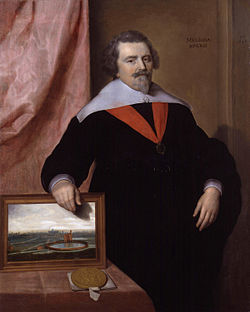New River

The New River is an artificial waterway in Hertfordshire and Middlesex. It was opened in 1613 to supply London with fresh drinking water taken from the River Lea and from Amwell Springs (which had ceased to flow by the end of the 19th century),[1] and from other springs and wells along its course.
Route
The New River starts between Ware and Hertford in Hertfordshire, taking its water from the River Lea there. Today it runs 20 miles down to Stoke Newington. Among the places through which it flows (from north to south) are:

- Hertfordshire:
- Middlesex:
- Enfield
- Palmers Green
- Bowes Park
- Wood Green (passing close to Alexandra Palace)
- Hornsey
- Harringay
- Finsbury Park
The river’s original termination point was at New River Head near Clerkenwell, close to the current location of Sadler's Wells theatre (where water from the river was used to flood a large tank to stage an Aquatic Theatre at the beginning of the 19th century).[2] In 1946 the water supply to New River Head was truncated at Stoke Newington so that the New River ended at the East Reservoir.
At Clissold Park in Stoke Newington, the river flows underground to emerge south of St Paul's Road in Canonbury.
Today by following the New River Path it is possible to walk almost the whole length of the New River from its source between Hertford and Ware to its current destination in Stoke Newington, Middlesex. [3]
Construction


The design and construction of the New River is often attributed solely to Sir Hugh Myddelton. However, Edmund Colthurst first proposed the idea in 1602, obtaining a charter from King James I in 1604 to carry it out. However, after surveying the route and digging the first two-mile long stretch, Colthurst encountered financial difficulties and it fell to Myddelton to complete the work between 1609 and its official opening on 29 September 1613. Myddelton gave some of the shares in the New River Company to Colthurst.
The expense and engineering challenges of the project—it relied on gravity to allow the water to flow, carefully following the contours of the terrain from Ware into London, and dropping around just five inches per mile were not Myddelton's only worries. He also faced considerable opposition from landowners who feared that the New River would reduce the value of their farmland (they argued that floods or overflowing might create quagmires that could trap livestock); others were concerned at the possible disruption to road transport networks between Hertfordshire and the capital. Myddelton, however, was strongly supported by the king, who agreed to pay half the project's expenses in return for a 50% shareholding; such backing quickly silenced the scheme's critics.
When it was originally constructed, long sections, for example around Forty Hall and in Hornsey, wound around the heads of small tributary valleys of the Lea. Other sections of the river, including the one in Harringay, were carried across valleys in wooden aqueducts lined with lead and supported by strong timbers and brick piers. In at least one section, locals referred to the river as the boarded river. Improvements in canal making in the 18th century led to these sections being replaced by clay-banked canals.[4]
The Dame Alice Owen's School bombing
On 15 October 1940, approximately 150 people were sheltering in the basement of Dame Alice Owen's School, then on Goswell Road. A large parachute bomb hit the building directly, causing the structure to collapse and blocking access to the basement. The blast wave from the bomb caused the pipeline carrying the New River to rupture, flooding the shelter and killing the majority of those sheltering.[5]
A memorial to the victims of the bombing stands in Owen's Fields at the northern end of Goswell Road.
Modern alterations

A winding original section of the channel that used to run through the town centre of Enfield has been cut off from the main flow, but is still maintained as an important local civic amenity, called the New River Loop. Another semi-redundant section of the New River's course between Canonbury and Islington town centre now forms a picturesque walk alongside the now shallow stream.
Originally the course was above ground throughout, but in the second half of the 19th Century some sections were put underground, enabling the course to be straightened. The picture (right) shows where the river now disappears underground in Hackney to reappear in Islington. This section used to run along the route of Petherton Road in Highbury. The algal bloom shows how stagnant the water is at this point, most of it being diverted into London's water supply just north of Clissold Park.
The New River Company was taken over by the Metropolitan Water Board in 1904 and became part of Thames Water in 1973. The northern part of the New River is still an important link in the supply of water to London.
| ("Wikimedia Commons" has material about the New River in Middlesex) |
| ("Wikimedia Commons" has material about the New River in Hertfordshire) |
Outside links
References
- ↑ Guide to the Waterways 1 London,Grand Union,Oxford&Lee Published by Nicholson& Ordnance Survey (1997) p.104 ISBN 0-7028-3296-0 Retrieved 4 January 2008
- ↑ Victorian Theatres in London accessed 14 September 2009
- ↑ The New River Path – a walk linking Hertford with Islington accessed 27 October 2011
- ↑ History of Tottenham, William Robinson, 1840
- ↑ "Unveiling of Memorial to the Victims of the London Blitz". Dame Alice Owen's School. http://www.school-portal.co.uk/GroupRenderCustomPage.asp?GroupID=64099&ResourceId=238992. Retrieved 2007-05-11.
Further reading
- Camden New Journal article, "Water a lot of history we have on tap" (11 December 2003)
- Chambers Book of Days 29 September
- Ward, Robert. London's New River. London: Historical Publications, 2003. ISBN 978-0-948667-84-8 (out of print)